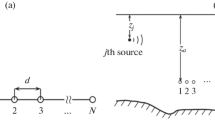Abstract
The problem of acoustic source localization in a range-dependent waveguide with interaction of normal waves, which leads to their amplitude coupling, is considered. For the given scenario, an adaptive reduced-rank algorithm is constructed, taking into account the difference between the expected signal replica and the true one and does not require knowledge of the corresponding coupling elements. By statistical modeling, it is found that the proposed estimation method gives a significant advantage both in the accuracy of coordinate measurement and in the probability of correct localization compared to the traditional MUSIC method, which does not take into account the effects of mode interaction.



Similar content being viewed by others
REFERENCES
A. B. Baggeroer, W. A. Kuperman, and P. N. Mikhalevsky, IEEE J. Oceanic Eng. 18, 401 (1993).
A. G. Sazontov and A. I. Malekhanov, Acoust. Phys. 61 (2), 213 (2015).
Robust Adaptive Beamforming, Ed. by J. Li and P. Stoica (John Wiley & Sons, Hoboken, NJ, 2006).
L. M. Brekhovskikh and Yu.P. Lysanov, Theoretical Foundations of Ocean Acoustics (Gidrometeoizdat, Leningrad, 1982) [in Russian].
B. Friedlander and A. Weiss, IEEE Trans. Antennas Propag. 39 (3), 273 (1991).
A. M. Elbir, IEEE Antennas Wireless Propag. Lett. 16, 1541 (2017).
Q. Ge, Y. Zhang, and Y. Wang, IEEE Commun. Lett. 24 (1), 90 (2020).
R. O. Schmidt, IEEE Trans. Antennas Propag. 34 (3), 276 (1986).
M. Pesavento, A. B. Gershman, and K. M. Wong, IEEE Trans. Signal Process. 50 (9), 2103 (2002).
C. M. S. See and A. B. Gershman, IEEE Trans. Signal Process. 52 (2), 329 (2004).
P. Stoica and A. Nehorai, IEEE Trans. Acoust. Speech, Signal Process. 37 (5), 720 (1989).
A. Nehorai and E. Paldi, IEEE Trans. Signal Process. 42 (2), 376 (1994).
ACKNOWLEDGMENTS
This work was supported by the Russian Science Foundation, project no. 20–19–00383.
Author information
Authors and Affiliations
Corresponding author
Additional information
Translated by E. Golyamina
APPENDIX
APPENDIX
THE CRAMER–RAO BOUND
For the chosen problem statement, sample observation vector \({{{\mathbf{x}}}_{l}}\) is a complex Gaussian vector with zero mean and covariance matrix Γx determined by Eq. (7). Channel transfer function \({\mathbf{G}}({\boldsymbol{\mathbf{\theta }}})\) appearing in Eq. (7) depends not only on the desired parameter \({\boldsymbol{\mathbf{\theta }}} = {{({\boldsymbol{\mathbf{\theta }}}_{1}^{T}, \ldots ,{\boldsymbol{\mathbf{\theta }}}_{J}^{T})}^{T}},\) but also on set of vectors \(\{ {{{\mathbf{c}}}_{j}}\} _{{j = 1}}^{J}\) consisting of the elements of the corresponding coupling matrices. In its turn, as mentioned above, any vector \({{{\mathbf{c}}}_{j}}\) can only be found accurate to an arbitrary complex factor. Consequently, without loss of generality, one of the elements of each individual vector \({{{\mathbf{c}}}_{j}}\) (e.g., the first one) can be considered to be fixed.
Let \({\mathbf{\alpha }}\) be a vector containing \(2PJ\) unknown real parameters of the transfer matrix:
where \({\mathbf{\eta }} = {{({{{\mathbf{\xi }}}^{T}},{{{\mathbf{\zeta }}}^{T}})}^{T}},\) and quantities \({\mathbf{\xi }} = {{({\mathbf{\xi }}_{2}^{T} \cdots ,{\mathbf{\xi }}_{P}^{T})}^{T}}\) and \({\mathbf{\zeta }} = {{({\mathbf{\zeta }}_{2}^{T}, \cdots ,{\mathbf{\zeta }}_{P}^{T})}^{T}}\) are \((P - 1)J \times 1\) vectors of the following form:
The covariance matrix of measurement error for vector \({\mathbf{\alpha }}\) satisfies the inequality
where \({\mathbf{CRB}}\,({\mathbf{\alpha }})\) is the lower Cramer–Rao bound, which determines the potentially attainable accuracy for the estimate of this vector. In the case of random signal reception against white noise, the corresponding bound does not depend on the measurement accuracy of both noise level and elements of signal matrix \({\mathbf{S}}\) and is given by the well-known formula [10, 12]:
where \({\mathbf{W}}{\kern 1pt} \,\, = {\mathbf{S}}{{{\mathbf{G}}}^{ + }}{\mathbf{\Gamma }}_{{\mathbf{x}}}^{{ - 1}}{\mathbf{GS}} \in {{C}^{{J \times J}}},\) and \({\mathbf{\Pi }}_{{\mathbf{G}}}^{ \bot } = {\mathbf{I}} - {\mathbf{G}}{{({{{\mathbf{G}}}^{ + }}{\mathbf{G}})}^{{ - 1}}}{{{\mathbf{G}}}^{ + }} \in {{C}^{{N \times N}}}.\) Calculating the derivatives involved in (A2) and introducing the notation
\({{{\mathbf{D}}}_{p}} = \left[ {{\mathbf{UT}}({{{\boldsymbol{\mathbf{\theta }}}}_{1}}){\kern 1pt} {\kern 1pt} {{{\mathbf{e}}}_{p}}, \ldots ,{\mathbf{UT}}({{{\boldsymbol{\mathbf{\theta}}}}_{J}}){\kern 1pt} {\kern 1pt} {{{\mathbf{e}}}_{p}}} \right]{\kern 1pt} {\kern 1pt} {\kern 1pt} ,\) where \(p = 2, \ldots ,P,\) and \({{{\mathbf{e}}}_{p}}\) represents the \(p\)th column of the \(P \times P\) identity matrix, for \({\mathbf{CRB}}\,({\mathbf{\alpha }})\) we obtain
Here, \(\;{{{\mathbf{J}}}_{{{\mathbf{\theta \theta }}}}} = \operatorname{Re} \{ {\mathbf{F}}\} \,,\)\({{{\mathbf{J}}}_{{{\mathbf{\theta \eta }}}}} = [\operatorname{Re} \{ {\mathbf{K}}\} - \operatorname{Im} \{ {\mathbf{K}}\} ],\) \({{{\mathbf{J}}}_{{{\mathbf{\eta \eta }}}}} = \left( {\begin{array}{*{20}{c}} {\operatorname{Re} \{ {\mathbf{\Sigma }}\} }&{ - \operatorname{Im} \{ {\mathbf{\Sigma }}\} } \\ {\operatorname{Im} \{ {\mathbf{\Sigma }}\} }&{\operatorname{Re} \{ {\mathbf{\Sigma }}\} } \end{array}} \right),\) where
and the symbol \( \circ \) indicates the Hadamard product (or element-by-element multiplication of matrices \({{[{\mathbf{A}} \circ {\mathbf{B}}]}_{{ij}}} = {{[{\mathbf{A}}]}_{{ij}}}{{[{\mathbf{B}}]}_{{ij}}}\)).
Below we will be interested in the accuracy limit of measuring the spatial positions of sources. The corresponding \(2J \times 2J\) error matrix is determined by inversion of the upper left block in Eq. (A3):
Expression (A4) is obtained using the result of [11], according to which
Rights and permissions
About this article
Cite this article
Sazontov, A.G. Source Localization in a Range-Dependent Waveguide with Incomplete Information on Spatial Variability of the Propagation Medium. Acoust. Phys. 68, 641–648 (2022). https://doi.org/10.1134/S1063771022060124
Received:
Revised:
Accepted:
Published:
Issue Date:
DOI: https://doi.org/10.1134/S1063771022060124



